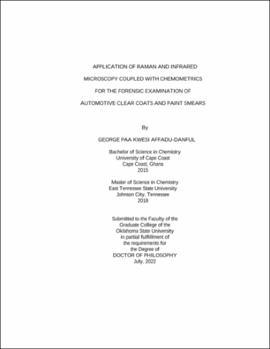| dc.contributor.advisor | Lavine, Barry K. | |
| dc.contributor.author | Affadu-Danful, George Paa Kwesi | |
| dc.date.accessioned | 2023-04-05T16:20:52Z | |
| dc.date.available | 2023-04-05T16:20:52Z | |
| dc.date.issued | 2022-07 | |
| dc.identifier.uri | https://hdl.handle.net/11244/337278 | |
| dc.description.abstract | Modern automotive paints typically use thinner undercoat and color coat layers protected by a thicker clear coat layer. All too often, a clear coat is the only layer of automotive paint left at the crime scene. Current approaches using automotive paint databases to identify clear coats have been unsuccessful because the FTIR spectra of clear coats are too similar to generate accurate hit lists by searching clear coat FTIR spectra alone. Recently published studies of pattern recognition methods applied to FTIR spectra of clear coats have shown that information about the line and model of a vehicle can be obtained from these spectra. To further enhance the general discrimination power of clear coats, Raman spectroscopy and pattern recognition techniques have been investigated as a better solution to the problem of extracting investigative lead information from automotive clear coats. The general discrimination power of Raman spectra for automotive paint comparisons involving 118 General Motors clear coat samples (6 assembly plants for the production years 2000-2006) have been compared to results previously obtained using FTIR spectroscopy. The results of the study show that Raman spectroscopy is a better solution to the problem of extracting investigative lead information from automotive clear coats than IR spectroscopy. | |
| dc.description.abstract | A procedure to simulate the type of paint smear generated in vehicle-vehicle collisions has also been developed. Currently, paint smears encountered in a vehicle collision cannot be created in a laboratory. To this end, testing accessories have developed and adapted to an impact tester which permitted the acquisition and analysis of a large number of paint smears on metal substrates. A machine learning approach to reconstruct IR spectra of the original layers from paint smears allowed searching of an in-house automotive paint library to seek a best match. The results of this study demonstrated that inter-comparisons of paint smears to OEM automotive paints using IR spectra alone to quantify discrimination power of OEM paint smears is feasible and the use of pattern recognition techniques can further efforts to communicate trace evidential significance to the courts. | |
| dc.format | application/pdf | |
| dc.language | en_US | |
| dc.rights | Copyright is held by the author who has granted the Oklahoma State University Library the non-exclusive right to share this material in its institutional repository. Contact Digital Library Services at lib-dls@okstate.edu or 405-744-9161 for the permission policy on the use, reproduction or distribution of this material. | |
| dc.title | Application of Raman and infrared microscopy coupled with chemometrics for the forensic examination of automotive clear coats and paint smears | |
| dc.contributor.committeeMember | El Rassi, Ziad | |
| dc.contributor.committeeMember | Materer, Nicholas F. | |
| dc.contributor.committeeMember | Bunce, Richard | |
| dc.contributor.committeeMember | Rosenberger, Albert T. | |
| osu.filename | AffaduDanful_okstate_0664D_17772.pdf | |
| osu.accesstype | Open Access | |
| dc.type.genre | Dissertation | |
| dc.type.material | Text | |
| dc.subject.keywords | automotive paint smears | |
| dc.subject.keywords | chemometrics | |
| dc.subject.keywords | machine learning | |
| dc.subject.keywords | microscopy | |
| dc.subject.keywords | Raman | |
| dc.subject.keywords | vibrational spectroscopy | |
| thesis.degree.discipline | Chemistry | |
| thesis.degree.grantor | Oklahoma State University | |
